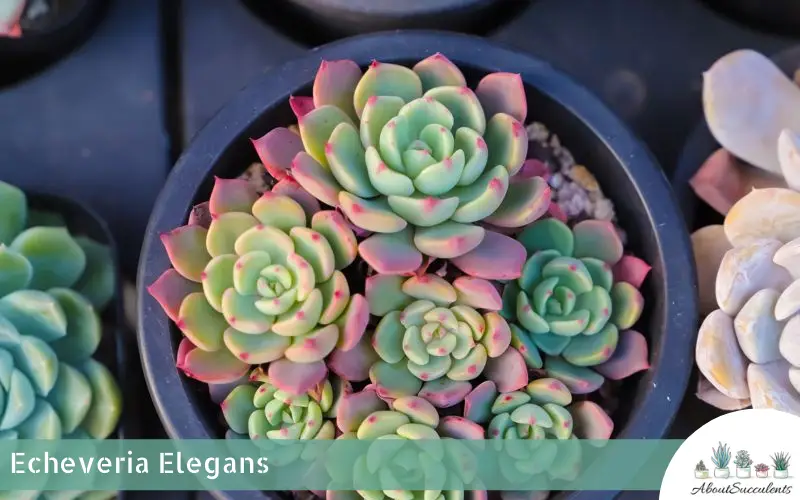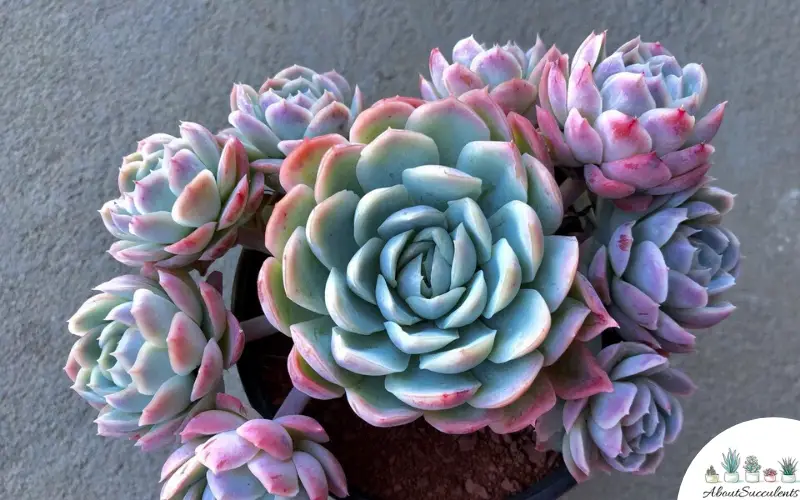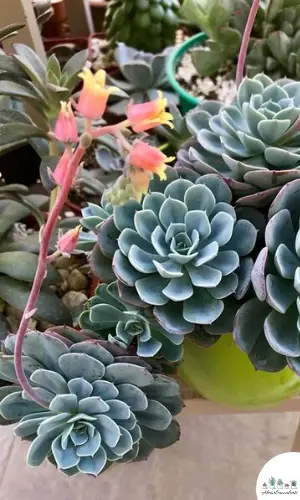
Echeveria elegans is a charming succulent that showcases a symmetrical spiral of bluish-white rosettes and thick, stumpy leaves. The shape of the succulent and its native habitat of Mexico have given Echeveria elegans the nickname “Mexican Snowball”.
Mexican Snowball is popular with succulent growers because it produces pink – sometimes red – flowers with attractive yellow-colored tips during the late winter to mid-summer months.
In Mexico, Echeveria elegans is a staple plant in many homes because it is believed that the succulent has the power to drive away evil spirits. As a celebrated succulent, Echeveria elegans is the recipient of the prestigious Award of Garden Merit of the Royal Horticultural Society.
Echeveria elegans comes from the Crassulaceae family and can grow up to 8-inches tall (20cm) and 12-inches wide (30.5cm).
General Information:
Also known as: Mexican Snowball, Hens and Chicken
Plant Family: Crassulaceae
Origin: Mexico
Height: 8-inches tall (20cm) and 12-inches wide (30.5cm)
Exposure: Full to partial sunlight up to 6 hours per day
Water Needs: Light watering schedule during the summer months; very little to no watering in the winter or cold season.
Soil Type: Sandy, succulent soil mix in combination with equal parts peat moss and perlite
Soil pH: Acidic (6.0 pH)
Tolerance: Drought
How to Grow Echeveria Elegans

Echeveria elegans is a slow-growing succulent. It may take years for the plant to reach full maturity.
Mexican Snowball still remains popular with garden hobbyists. The succulent is often used as ground cover or to adorn a rock garden. You might see Mexican Snowball used as a bouquet at a wedding.
Although Echeveria elegans is more tolerant of cold weather compared to other varieties of echeverias, if your area experiences a drop in temperature lower than 20° F (-6.7° C), it would be advisable to move the plant indoors.
1. Sunlight
Echeveria elegans is susceptible to stretching if not given enough sunlight. Stretching is the condition where the plant becomes weak and pallid.
If grown outdoors, plant Mexican Snowball in an area that receives 6 hours of morning sunlight per day.
When grown indoors, Mexican Snowball will thrive near a window that brings in sunlight. If this is not possible, place the succulent under a Grow Light.
2. Watering
Echeveria elegans is very tolerant to drought and does not need much watering. It is recommended to water Mexican Snowball only once per week in the summer. To be sure, check if the soil is dry to the touch. If it does not have signs of moisture, give the plant some water.
In the wintertime, Echeveria elegans will require less water because its soil will retain moisture much longer. If the plant does need water, restrict its volume to no more than a sprinkling on the pot or the ground. Remain observant. If the plant appears thinner, give it more water.
Like all succulents, overwatering can lead to root rot and kill the plant.
3. Pot and Soil
Use a pot that has excellent drainage. Make sure there is a tray underneath the pot to properly collect excess water. If a tray is not available, use pieces of a broken pot.
Echeveria elegans will grow properly when planted in a sandy, succulent soil mix. It is recommended to add a mix of equal parts peat moss and perlite to the soil to improve drainage.
It is also highly recommended to give Mexican Snowball a balanced fertilizer mix during the spring and summer seasons. Space the fertilizer feedings by about 1 month apart.
How to Propagate Echeveria Elegans

Echeveria elegans is very easy to propagate and the species responds well to 2 methods: Offsets and Cuttings.
1. Offsets
Echeveria elegans develops offsets in the springtime that sprout from the base of the succulent plant.
Step 1 – Gently pull up the offsets.
Step 2 – Set aside the offsets under a dry and shaded area.
Step 3 – Allow the offsets to harden or develop calluses.
Step 4 – Once the calluses have formed, plant the cuttings in a pot with well-draining soil.
2. Cuttings
Step 1 – Choose a healthy leaf from the plant.
Step 2 – Remove the leaf by cutting it off with a sharpened and sterilized knife or garden shears.
Step 3 – Place the leaf-cutting under a shaded area.
Step 4- Give it several days to harden or develop calluses.
Step 5 – Once the calluses have formed, place it in a pot filled with well-draining soil.
Step 6 – If the soil has dried out completely, give the plant more water.
Step 7 – Once it has taken root and there is the presence of a rosette, re-plant Mexican Snowball in a new pot.
Frequently Asked Questions
Is Echeveria Elegans Toxic for Cats and Dogs?
Echeveria elegans is not listed on the website of the American Society for the Prevention of Cruelty to Animals (ASPCA) as a toxic plant.
Mexican Snowball is safe to have in the garden or inside your home if you have cats or dogs.
Why is my Echeveria Elegans Succulent Dying?
If your Echeveria elegans succulent is dying, look into these 3 possible causes: Overwatering, Insufficient Sunlight, and Frost.
1. Overwatering
Echeveria elegans can survive long periods without water. It is better to restrict the plant’s water intake than to give it too much water.
Overwatering will cause Mexican Snowball’s roots to rot. The rotting will not be localized and will spread to other parts of the plant. If you see sections of the plant turning brownish or blackish in color, cut off the part right away as it may infect Echeveria elegans as a whole.
2. Insufficient Sunlight
Echeveria elegans is a variety of succulent that loves the sunlight. Lack of sun exposure will cause the plant to wither and die.
Make sure the plant gets adequate sunlight of at least 6 hours per day.
3. Frost
Echeveria elegans does not love cold weather. Frost can lead to the plant developing a blackish color which is indicative of deterioration. In cold climates, Mexican Snowball will not last long and should be grown indoors.
Does Echeveria Elegans Produce Flowers?
Yes, Echeveria elegans goes into bloom during the late winter to mid-summer months. Its pretty pink flowers are one of the best reasons growers love to propagate Mexican Snowball.
The flowers are small; measuring only 0.39-inches or 10mm in length.
Last Updated on June 10, 2022 by Sofia Lara